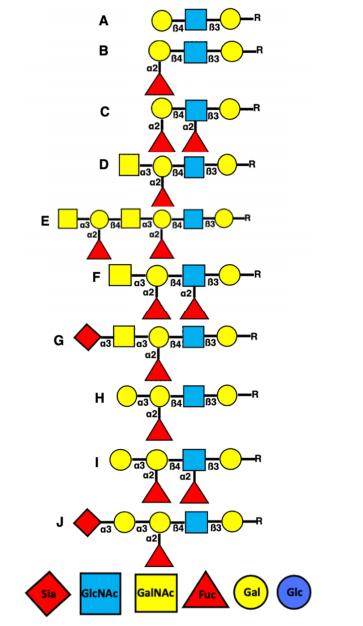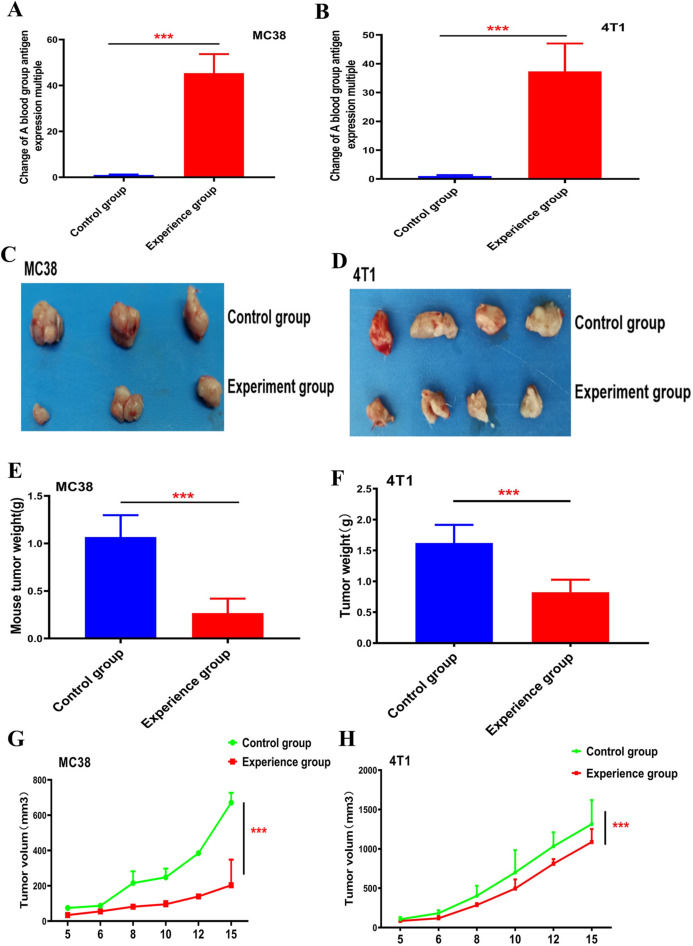Blood Group Antigen Introduction
Accelerate Your Glycan-Based Discoveries!
Are you currently facing challenges in precisely characterizing diverse blood group antigen variants, developing highly specific anti-glycan antibodies, or navigating the complexities of glycan-mediated immunological responses? Our Blood Group Antigen services at Creative Biolabs help you accelerate critical research, obtain unparalleled insights into glycan structures, and develop targeted solutions through advanced glycan analysis and innovative antibody engineering techniques.
Contact our team to get an inquiry now!
Blood Group Antigen
Erythrocyte (RBC) antigens govern an individual's blood group. Major systems include ABO (types A, B, AB, O) and Rh (D-positive or D-negative). Blood group determinants are carbohydrates or proteins; ABO antigens are sugars, while Rh antigens are proteins. These markers attach to diverse components within the erythrocyte membrane.
The figure below displays the RBC membrane and selected blood group antigens bound to it. Beyond glycan (carbohydrate) antigens, the erythrocyte membrane incorporates three protein classes: single-pass, multi-pass, and glycosylphosphatidylinositol (GPI)-anchored proteins, which bear blood group antigens.
 Fig.1 Illustration of various blood group antigens (A, B, D, E, G).1,3
Fig.1 Illustration of various blood group antigens (A, B, D, E, G).1,3
Expression
Typically, these antigens act as external markers on RBC membranes. However, these antigens extend beyond red cells and even hematopoietic tissues. ABO system antigens exhibit broad tissue distribution, identified on platelets, leukocytes, skin, kidney, urinary tract, gastrointestinal (GI) tract epithelium, and vascular endothelium.
They are located on N-glycoproteins, O-glycoproteins, and glycolipids in erythrocytes and multiple body cells. Their synthesis occurs on type 1-4 chains. Type 1 chains feature Galβ1-3GlcNAc-R, while type 2 contain Galβ1-4GlcNAc-R. Both exist on N-/O-glycoproteins and glycolipids. Type 2 chains occur universally, while type 1 chains are confined solely to the GI tract. Type 3 and 4 chains both utilize Galβ1-3GalNAc-R, though their R groups differ: type 3 employs serine (Ser) or threonine (Thr) within O-glycopeptides, while type 4 typically uses a glycolipid moiety.
Biosynthesis
Blood group antigen production requires at least two stages. Initial production generates the H antigen, corresponding to type O. Later formation generates either A or B structures. H antigen generation involves α1,2-fucose attachment to terminal galactose on type 1-4 chains. Following H precursor formation, A/B transferases—distinguished by four amino acids—employ this substrate to produce A/B antigens on type 1-4 chains. Two genetic loci encode H transferase. The H locus operates in erythrocytes, while the secretor locus functions in gastrointestinal epithelial cells, named for antigens from secreted glycoconjugates. These enzymes also critically enable the formation of multiple Lewis antigens.
Clinical Significance of ABO Antibodies
I. Transfusion reactions
Blood group antigens function in identifying non-self cells within circulation. For instance, if a type A individual receives type B blood, the recipient's immune system will identify the donor cells as foreign and trigger a defensive reaction. Anti-B antibodies are produced to attack and destroy type B erythrocytes. Standard blood typing and cross-matching procedures for transfused products should avert negative transfusion responses caused by ABO immune proteins. Such incompatibility may result in severe morbidity or mortality.
II. Hemolytic disease of the newborn (HDN)
Most instances of hemolytic disease of the newborn (HDN) resulting from ABO incompatibility necessitate no intervention. Severe hemolytic cases requiring therapeutic exchanges are infrequent. This condition caused by ABO immune proteins occurs predominantly in type A/B neonates born to group O mothers. HDN typically exhibits milder manifestations since fetal erythrocytes express lower A/B antigen levels than adult cells. However, fetal blood group antigen strength varies, making hemolysis extent and disease severity unpredictable.
Notably, ABO antibodies hold major clinical importance for two reasons: (a) they arise naturally and are universally present; (b) they demonstrate potent reactivity. For further details about these factors, please contact us.
Published Data
 Fig.2 The effect of blood group A antigen on tumor formation.2,3
Fig.2 The effect of blood group A antigen on tumor formation.2,3
In a compelling experiment, a mouse model was established where mice were engineered to express blood group A antibodies. Colorectal and breast cancer cells were subsequently injected into the axillae of these mice to create solid tumors. The core intervention involved the intratumoral injection of a lentivirus designed to express blood group A antigens directly within the tumor. A key finding was that this localized expression of the blood group antigen led to a significant reduction in tumor volume in the treated mice compared to control groups. Further analysis of the treated tumors revealed a notable increase in the C5b-9 complement membrane attack complex, indicating a robust activation of the complement system. Additionally, an elevated proportion of Natural Killer (NK) cells was observed within the treated tumors, suggesting a broader immune activation. Supporting these in vivo results, in vitro studies showed that tumor cells genetically modified to display blood group A antigens had markedly reduced proliferation rates when incubated with anti-A serum. These results collectively indicate that the strategic introduction of ABO blood group antigens can indeed stimulate the body's immune system, specifically activating the complement system and enhancing NK cell activity, to effectively eliminate tumor cells, proposing a powerful tool for tumor treatment.
What We Can Offer?
Creative Biolabs is a leading provider of comprehensive solutions for blood group antigen research and anti-glycan antibody development. Our offerings are tailored to meet the diverse needs of the biopharmaceutical industry and academic research.
- Custom Blood Group Antigen Synthesis
- Anti-Blood Group Antigen Antibody Development
- Antibody Engineering and Optimization
- Functional Assays for Antibody Validation
- Glycan-Mediated Immunological Studies
Access the Creative Biolabs Benefit – Request Pricing Immediately
Why Choose Us?
Creative Biolabs stands out as a premier partner in Blood Group Antigen research due to our unparalleled expertise, cutting-edge technology, and commitment to scientific excellence.
- Comprehensive Glycan Analysis Platform
- Innovative Antibody Engineering
- Deep Understanding of Immunological Complexities
- Customized Solutions
- Rigorous Quality Control
FAQs
Q: What approaches are available for studying rare or uncharacterized blood group antigens?
A: Advanced glycan profiling techniques can facilitate novel antigen characterization. This involves elucidating unique carbohydrate structures and subsequently generating highly specific reagents, even for the rarest antigens. Experts in the field are adept at tailoring solutions for such complex studies.
Q: What are the advantages of custom-developed anti-glycan antibodies over standard commercial options?
A: Custom-developed anti-glycan antibodies often provide superior specificity and affinity because they are precisely engineered for a specific target and application. This can lead to more reliable and impactful results in research or diagnostic assays by reducing off-target effects and false positives. Tailored solutions can offer significant advantages.
Q: Can glycan profiling and specific antibodies be utilized to understand the role of blood group antigens in disease progression?
A: Yes, precise glycan profiling combined with the use of specific anti-glycan antibodies is highly effective for such investigations. This approach can help identify alterations in blood group antigen expression associated with various disease states, potentially uncovering novel biomarkers for diagnostics or promising therapeutic targets. Collaboration on disease research utilizing these tools is often highly productive.
Related Products and Services
To further advance your glycobiology R&D, we provide a portfolio of solutions:
- Monoclonal Antibodies
- Polyclonal Antibodies
- Secondary & Tag Antibodies
- Isotype & Loading Control Antibodies
- Carbohydrate Antigens
Creative Biolabs also provides related services, click the buttons to find more details.
Creative Biolabs offers a series of anti-glycan antibody-related services for worldwide customers. To explore these capabilities, please contact us for more information.
References:
- Mironov, Alexander A et al. "Mechanisms of Formation of Antibodies against Blood Group Antigens That Do Not Exist in the Body." International journal of molecular sciences vol. 24,20 15044. 10 Oct. 2023, DOI:10.3390/ijms242015044.
- Luo, Qiong et al. "ABO blood group antigen therapy: a potential new strategy against solid tumors." Scientific reports vol. 11,1 16241. 10 Aug. 2021, DOI:10.1038/s41598-021-95794-x
- Distributed under Open Access license CC BY 4.0, without modification.
